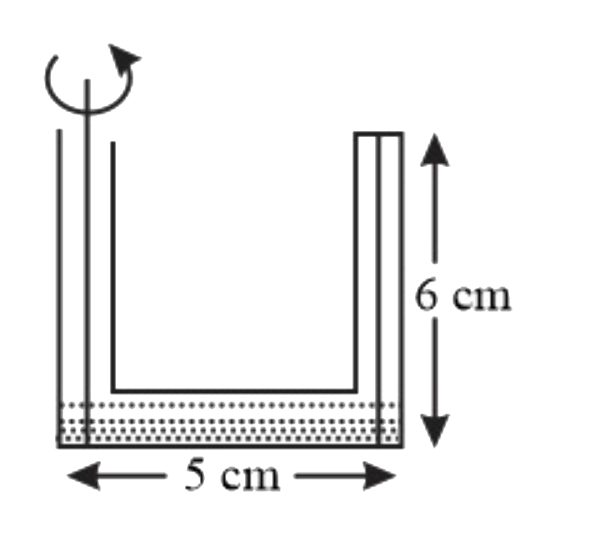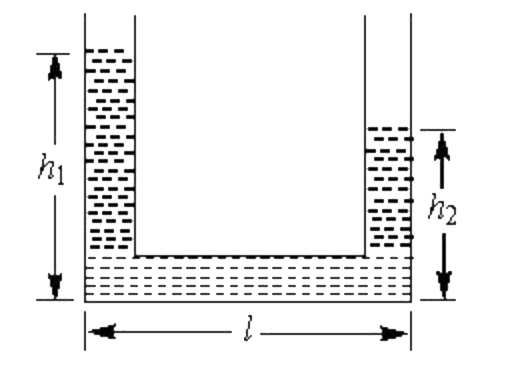A U-tube having horizontal arm of length 20 cm, has uniform cross-sectional area, It is filled with water of volume 60 cc. What volume of a liquid of density should be poured from one side into the U-tube so that no water is left in the horizontal arm of the tube? a) 60 cc b) 45 cc c) 50 cc d) 35 cc
The correct Answer is:D
To solve the problem, we need to determine the volume of a liquid with a density of 4 g/cc that should be poured into one side of the U-tube so that no water remains in the horizontal arm.
1. Understand the U-tube Setup:
- The U-tube has a horizontal arm of length 20 cm and a uniform cross-sectional area of 1 cm².
- It is initially filled with 60 cc of water.
2. Identify the Variables:
- Density of water (ρ1) = 1 g/cc
- Density of the new liquid (ρ2) = 4 g/cc
- Volume of water (V_water) = 60 cc
- Let the volume of the new liquid poured in be V_new.
3. Calculate the Height of Water in the U-tube:
- The volume of water in the horizontal arm can be calculated using the formula:
V=A⋅h
where A is the cross-sectional area and h is the height.
- Given that the area A = 1 cm², the height of water (h_water) in the horizontal arm can be calculated as:
hwater=VwaterA=60 cc1 cm2=60 cm
4. Set Up the Equilibrium Condition:
- When the new liquid is poured in, it will displace the water in the horizontal arm. For equilibrium, the pressure exerted by the water column must equal the pressure exerted by the new liquid column.
- The height of the new liquid (h_new) can be expressed as:
hnew=VnewA=Vnew1 cm2=Vnew cm
5. Apply the Pressure Balance:
- The pressure balance condition can be expressed as:
ρ1ghwater=ρ2ghnew
- Since g cancels out, we have:
1⋅60=4⋅hnew
- Rearranging gives:
hnew=604=15 cm
6. Calculate the Total Volume:
- The total height of liquid in the U-tube must equal the length of the horizontal arm (20 cm). Therefore, the height of the water plus the height of the new liquid must equal 20 cm:
hwater+hnew=20 cm
- Substituting the known values:
60+hnew=20
- Since we already found hnew=15 cm, we can find the total volume of the new liquid:
Vnew=hnew⋅A=15⋅1=15 cc
7. Final Calculation:
- The total volume of liquid needed to ensure no water remains in the horizontal arm is:
Vnew=20 cm−60 cm=35 cc
Conclusion:
The volume of the liquid with a density of 4 g/cc that should be poured into the U-tube is 35 cc.
- The U-tube has a horizontal arm of length 20 cm and a uniform cross-sectional area of 1 cm².
- It is initially filled with 60 cc of water.
- Density of water (ρ1) = 1 g/cc
- Density of the new liquid (ρ2) = 4 g/cc
- Volume of water (V_water) = 60 cc
- Let the volume of the new liquid poured in be V_new.
- The volume of water in the horizontal arm can be calculated using the formula:
V=A⋅h
where A is the cross-sectional area and h is the height.
- Given that the area A = 1 cm², the height of water (h_water) in the horizontal arm can be calculated as:
hwater=VwaterA=60 cc1 cm2=60 cm
- When the new liquid is poured in, it will displace the water in the horizontal arm. For equilibrium, the pressure exerted by the water column must equal the pressure exerted by the new liquid column.
- The height of the new liquid (h_new) can be expressed as:
hnew=VnewA=Vnew1 cm2=Vnew cm
- The pressure balance condition can be expressed as:
ρ1ghwater=ρ2ghnew
- Since g cancels out, we have:
1⋅60=4⋅hnew
- Rearranging gives:
hnew=604=15 cm
- The total height of liquid in the U-tube must equal the length of the horizontal arm (20 cm). Therefore, the height of the water plus the height of the new liquid must equal 20 cm:
hwater+hnew=20 cm
- Substituting the known values:
60+hnew=20
- Since we already found hnew=15 cm, we can find the total volume of the new liquid:
Vnew=hnew⋅A=15⋅1=15 cc
- The total volume of liquid needed to ensure no water remains in the horizontal arm is:
Vnew=20 cm−60 cm=35 cc
The volume of the liquid with a density of 4 g/cc that should be poured into the U-tube is 35 cc.
Topper's Solved these Questions
- FLUID MECHANICSBOOK - DC PANDEY ENGLISHCHAPTER - FLUID MECHANICSEXERCISE - Level 2 More Than One Correct
10 Videos
- FLUID MECHANICSBOOK - DC PANDEY ENGLISHCHAPTER - FLUID MECHANICSEXERCISE - Level 2 Comprehension Based
7 Videos
- FLUID MECHANICSBOOK - DC PANDEY ENGLISHCHAPTER - FLUID MECHANICSEXERCISE - Subjective Question
2 Videos
- EXPERIMENTSBOOK - DC PANDEY ENGLISHCHAPTER - EXPERIMENTSEXERCISE - Subjective
15 Videos
- GENERAL PHYSICSBOOK - DC PANDEY ENGLISHCHAPTER - GENERAL PHYSICSEXERCISE - INTEGER_TYPE
2 Videos
Similar Questions
Length of the horizontal arm of a uniform cross - section U - tube is l = 5 cm and both ends of the vertical arms are open to the surrounding pressure of 7700 N m−2. A liquid of density ρ=103 kg m−3 is poured into the tube such that the liquid just fills the horizontal part of the tube. Now, one of the open ends is sealed and the tube. Now, one of the open ends is sealed and the tube is then rotaed about a vertical axis passing through the other veritcal arm with angular velocity ω due to which the liquid rises up to half the length of the vertical arm. If length of each vertical arm is a = 6 cm. What is the value of ω(in rad s−1)?

View SolutionLength of horizontal arm of a uniform cross section U-tube is l=21cm and ends of both of the vertical arms are open to surrounding of pressure 10500N/m2. A liquid of density ρ=103kg/m3 is poured into the tube such that liquid just fills the horizontal part of the tube. Now one of the open ends is sealed and the tube is then rotated about a vertical axis passing through the other vertical arm With angular velocity ω0=10rad/s. If length of each vertical arm is a=6cm, calculate the length of air column in the sealed arm. (in cm)

View SolutionA circular tube of uniform cross section is filled with two liquids densities ρ1 and ρ2 such that half of each liquid occupies a quarter to volume of the tube. If the line joining the free surfaces of the liquid makes an angle θ with horizontal find the value of θ.

View Solution_E01_110_Q01.png)
The U-tube shown has uniform cross-section A liquid is filled in the two arms up to height h1 and h2 and then the liquid is allowed to move neglect viscosity and surface tension. When the levels equalize in the two arms, the liquid will
View SolutionA liquid of density ρ is filled in a U-tube is accelerated with an acceleration a so that the height of liquid in its two vertical arms are h1andh2 as shown in the figure. If l is the length of horizontal arm of the tube, the acceleration a is

View SolutionAn open U-tube contains mercury. When 11.2 cm of water is poured into one of the arms of the tube, how high does the mercury rise in the other arm from its initial level ?
View SolutionA U-tube of uniform cross-sectional area and open to the atmosphere is partially filled with mercury. Water is then poured into both arms. If the equilibrium configuration of the tube is as shown in figure with h2=1.0cm, determine the value of h1
 .
.
View Solution_S01_015_Q01.png)
A vertical U-tube of uniform cross-section contains mercury in both arms A glycerine (relative density =1.3) column of length 10 cm is introduced into one of the arms. Oil of density 800 gm m−3 is poured into the other arm until the upper surface of the oil and hlycerine are at the same horizontal level, find the length of the column. Density of mercury is 13.6×103kgm−3
View SolutionWater is flowing through a horizontal tube of non-uniform cross-section. At a place, the radius of the tube is 1.0cm and the velocity of water is 2m/s. What will be the velocity of water where the radius of the pipe is 2.0cm?
View SolutionThe U-tube shown in the figure has a uniform cross section. A liquid is filled up to heights h1 and h2 in the two arms and they are allowed to move. Neglecting viscosity and surface tension, find the state of the liquid when the levels equalize in the two arms. Find the correct statement.

View Solution
